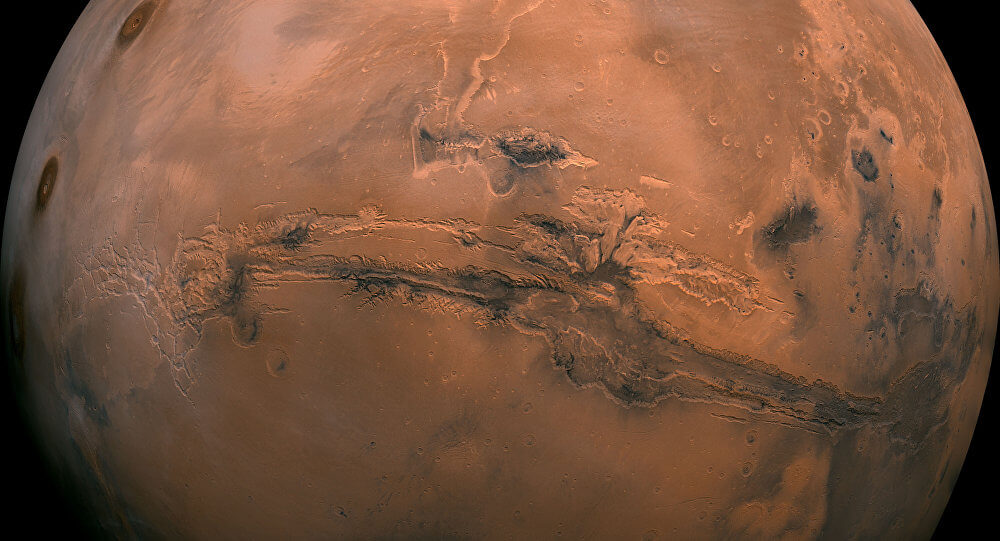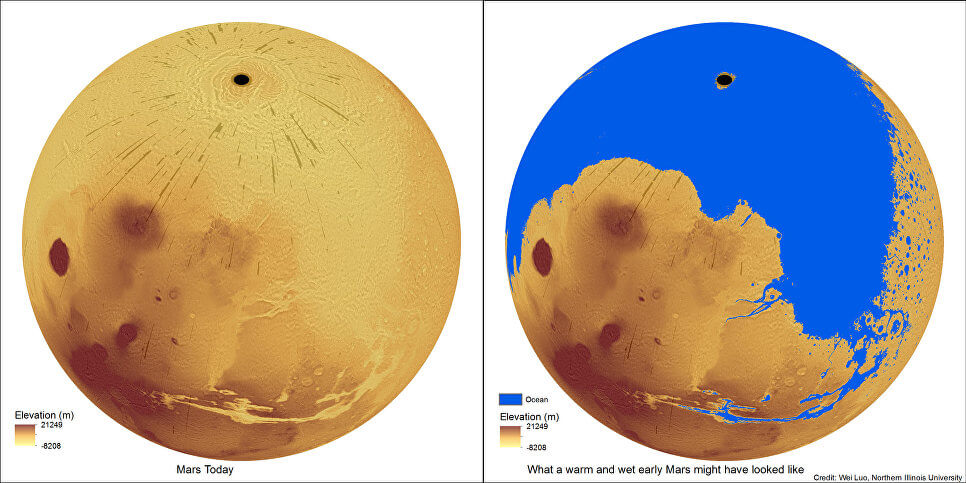
According to the findings of scientists from the University of California at Berkeley, published in the journal Nature, the first oceans on Mars appeared about 4 billion years ago and 200-300 million years earlier than was commonly believed.
“Scientists have always believed that the plateau of Tharsis, the largest volcanic landforms on Mars, appeared before the oceans were born of Mars some 3.7 billion years ago. We found that the oceans or encounter with him or appeared before,” said Michael Manga, a geologist at the University of California at Berkeley.
In recent years, active studies of the red planet, planetary scientists have found many hints that the ancient Mars there were rivers, lakes, entire oceans of water that contained almost the same amount of liquid as our earth’s Arctic ocean. These findings, however, agree not all. Some scientists believe that even in ancient times, Mars could be too cold for the continued existence of the oceans, if water existed in liquid form on the planet, only during the eruptions.
Recent observations of Mars using ground-based telescopes showed that over the past 3.7 billion years, Mars lost so much water that it would be enough to cover the entire surface of the planet ocean with a thickness of 140 meters. Where did this water go? Scientists do not yet know the answer, so today trying to figure that out, by studying the ancient Martian meteorites that fall to Earth.
Studying the structure of the coastline of the alleged ocean of the red planet, which covered a large part of the Northern hemisphere in the distant past, Manga and his colleagues found that the oceans appeared on Mars 200-300 million years earlier than stated in the conclusions of earlier research.

Mars is now (left) and how it may have looked like in the past (right)
According to the Manga, many planetary scientists doubt the very existence of this structure, as part of the bottom of this ocean located in the “wrong” places, where the water was supposed to flow from the bottom up to cover the entire surface. In addition, to doubt cause regions that looks too deep and others too shallow to constitute a single body of water with a common water level.
California geologists have found an explanation for this, analyzing how the formation of the volcanic plateau of Tharsis could affect the birth and evolution of the Martian oceans, as well as drawing attention to one newly opened fact related to this major geological structure of Mars.
Exploring the plateau and the adjacent Northern plains, where presumably there was once an ocean on Mars, scientists noticed that many of the features associated with its coastline looked more ancient than the Tharsis and its associated volcanoes. This gave them the idea that this structure was not born before and after the formation of the oceans of Mars.
Following this idea, the scientists compared how the coastline changed these bodies of water, how fast growing Tharsis for about half a billion years after its formation. This comparison unexpectedly showed that virtually all of the distortions and oddities at the shoreline was related to how deformed the bottom of the ocean under the influence of the growing volcanoes.
Excluding all of these factors, the researchers found that the Arabian plain of Mars, representing the most ancient part of the bottom of its oceans, dates back to the formation of Farside, hundreds of millions of years before the alleged time of occurrence of the oceans the red planet.
The calculations showed that the Arabian ocean contained about three percent of the total volume of water contained in the oceans on Earth. In other words, he was approximately two times higher than modern Arctic ocean, and contained more water than the polar caps of the Earth. Scientists believe that it became liquid due to the heat, and greenhouse gases that produce volcanoes, including the Tharsis future.
In subsequent periods, the area and volume of this reservoir is constantly changing with the growth of Farside, and gave rise to strange features in the coastline of the Northern ocean of Mars and made it much deeper than it was originally. Scientists hope that the seismographs of the new lander Insight, which will go to Mars in may, to help test their theory.
Planetary scientists said, when Mars would appear to the oceans
Nikolai Khizhnyak